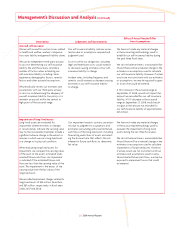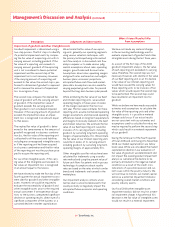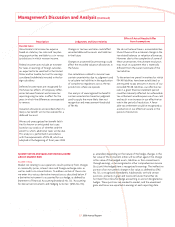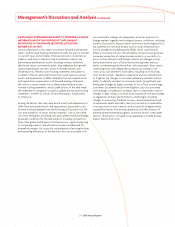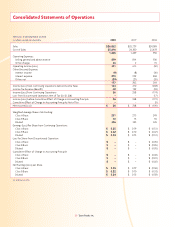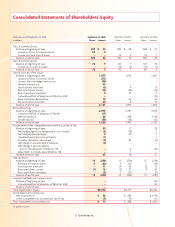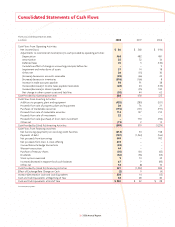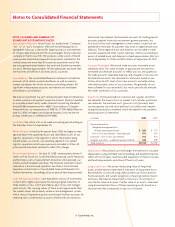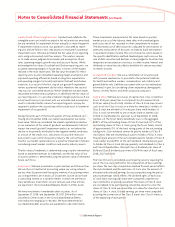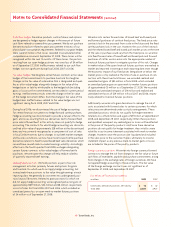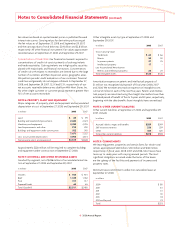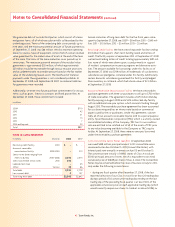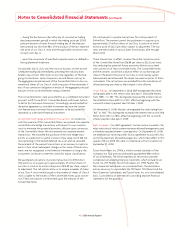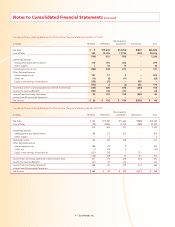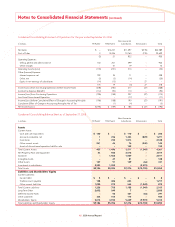Tyson Foods 2008 Annual Report Download - page 37
Download and view the complete annual report
Please find page 37 of the 2008 Tyson Foods annual report below. You can navigate through the pages in the report by either clicking on the pages listed below, or by using the keyword search tool below to find specific information within the annual report.
35 2008 Annual Report
Notes to Consolidated Financial Statements (continued)
Goodwill and Other Intangible Assets: Goodwill and indefi nite life
intangible assets are initially recorded at fair value and not amortized,
but are reviewed for impairment at least annually or more frequently
if impairment indicators arise. Our goodwill is allocated by report-
ing unit, and we follow a two-step process to evaluate if a potential
impairment exists. We have estimated the fair value of our reporting
units using a discounted cash fl ow analysis. This analysis requires
us to make various judgmental estimates and assumptions about
sales, operating margins, growth rates and discount factors. While
estimating the fair value of our Beef and Chicken reporting units, we
assumed operating margins in future years in excess of the margins
realized in the most recent year. The fair value estimates for these
reporting units assume normalized operating margin assumptions and
improved operating effi ciencies based on long-term expectations
and operating margins historically realized in the beef and chicken
industries. As a result of the fi rst step of our goodwill impairment
review, a potential impairment did not exist; therefore, the second
step was not considered necessary. While we believe we have made
reasonable estimates and assumptions to determine the fair value of
our reporting units, it is possible a material change could occur. If our
actual results are not consistent with our estimates and assumptions
used to calculate the fair value of our reporting units, we may be
required to perform the second step which could result in a material
impairment of our goodwill.
During the latter part of the fourth quarter of fi scal 2008 and con-
tinuing into November 2008, our market capitalization was below
book value. While we considered the market capitalization decline
in our evaluation of fair value of goodwill, we determined it did not
impact the overall goodwill impairment analysis as we believe the
decline to be primarily attributed to the negative market conditions
as a result of the credit crisis, indications of a possible recession
and current issues within the poultry industry. We will continue to
monitor our market capitalization as a potential impairment indicator
considering overall market conditions and poultry industry events.
The fair value of trademarks is determined using a royalty rate method
based on expected revenues by trademark, and the fair value of our
in-process patents is determined using the present value of estimated
future cash fl ows.
Investments: We have investments in joint ventures and other entities.
We use the cost method of accounting where our voting interests
are less than 20 percent and the equity method of accounting where
our voting interests are in excess of 20 percent, but we do not have
a controlling interest or a variable interest in which we are the pri-
mary benefi ciary. Investments in joint ventures and other entities
are reported in the Consolidated Balance Sheets in Other Assets.
We have investments in marketable debt securities. As of
September 27, 2008, and September 29, 2007, $94 million, were
classifi ed in Other Assets in the Consolidated Balance Sheets,
with maturities ranging up to 48 years. We have determined all
our marketable debt securities are available-for-sale investments.
These investments are reported at fair value based on quoted
market prices as of the balance sheet date, with unrealized gains
and losses, net of tax, recorded in other comprehensive income.
The amortized cost of debt securities is adjusted for amortization of
premiums and accretion of discounts to maturity. Such amortization
is recorded in interest income. The cost of securities sold is based on
the specifi c identifi cation method. Realized gains and losses on the
sale of debt securities and declines in value judged to be other than
temporary are recorded on a net basis in other income. Interest and
dividends on securities classifi ed as available-for-sale are recorded
in interest income.
Accrued Self Insurance: We use a combination of insurance and
self-insurance mechanisms to provide for the potential liabilities
for health and welfare, workers’ compensation, auto liability and
general liability risks. Liabilities associated with our risks retained are
estimated, in part, by considering claims experience, demographic
factors, severity factors and other actuarial assumptions.
Capital Stock: We have two classes of capital stock, Class A Common
Stock, $0.10 par value (Class A stock) and Class B Common Stock,
$0.10 par value (Class B stock). Holders of Class B stock may convert
such stock into Class A stock on a share-for-share basis. Holders of
Class B stock are entitled to 10 votes per share, while holders of
Class A stock are entitled to one vote per share on matters sub-
mitted to shareholders for approval. As of September 27, 2008,
members of the Tyson family benefi cially own, in the aggregate,
99.97% of the outstanding shares of Class B stock and 2.31% of the
outstanding shares of Class A stock, giving the Tyson family control
of approximately 70% of the total voting power of the outstanding
voting stock. Cash dividends cannot be paid to holders of Class B
stock unless they are simultaneously paid to holders of Class A stock.
The per share amount of the cash dividend paid to holders of Class B
stock cannot exceed 90% of the cash dividend simultaneously paid
to holders of Class A stock. We pay quarterly cash dividends to Class A
and Class B shareholders. We paid Class A dividends per share of
$0.16 and Class B dividends per share of $0.144 in each of fi scal years
2008, 2007 and 2006.
The Class B stock is considered a participating security requiring the
use of the two-class method for the computation of basic earnings
per share. The two-class computation method for each period refl ects
the cash dividends paid for each class of stock, plus the amount of
allocated undistributed earnings (losses) computed using the partici-
pation percentage, which refl ects the dividend rights of each class
of stock. Basic earnings per share were computed using the two-
class method for all periods presented. The shares of Class B stock
are considered to be participating convertible securities since the
shares of Class B stock are convertible on a share-for-share basis into
shares of Class A stock. Diluted earnings per share were computed
assuming the conversion of the Class B shares into Class A shares as
of the beginning of each period.


